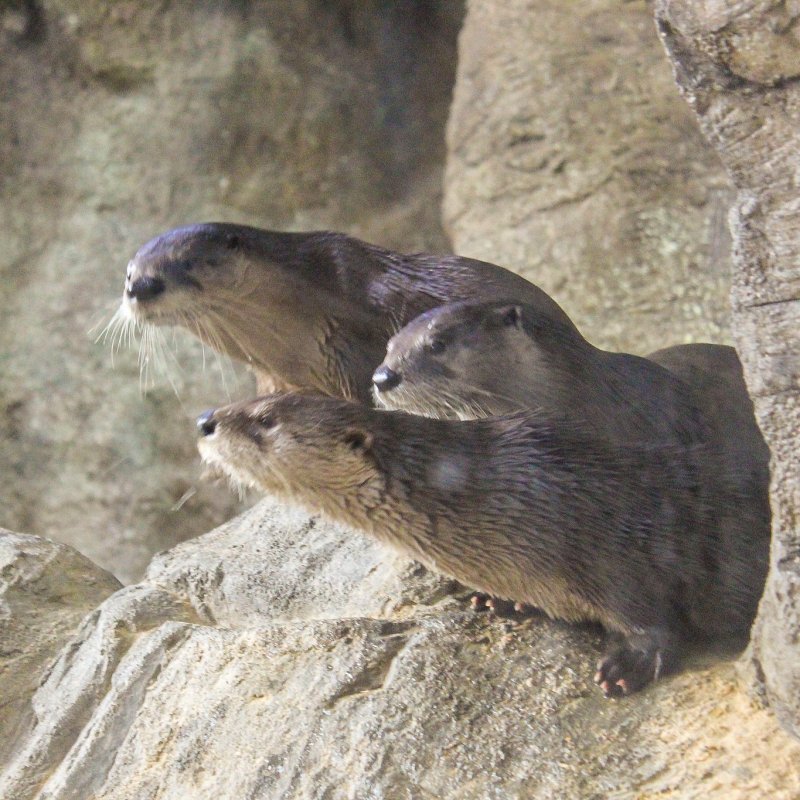On Exhibit
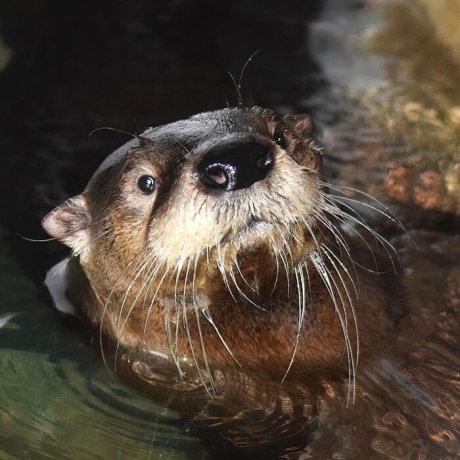
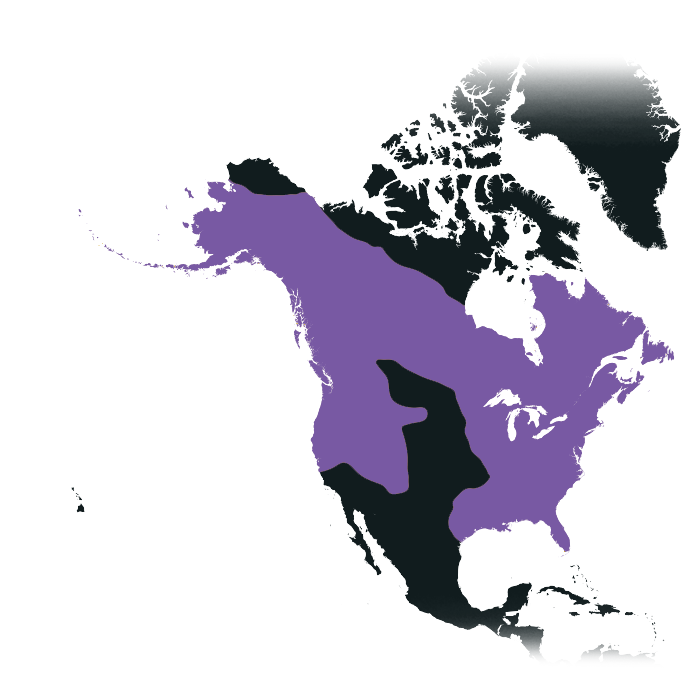
North America River Otter
Lontra canadensis
Our Animals
Our Animals: Toby, Cacy, Jordan, and Cedar- who are all named after tributaries of the Lehigh River Watershed. All males.
Size
30 to 60 in. (76-152 cm), with about 1/3 of that being tail. 11-30 lbs (5-14 kg)
Habitat
Nearly any freshwater or coastal wetland habitat including rivers and streams, lakes, marshes, swamps, estuaries, etc. Require unpolluted water, rich with food.
Conservation Status
Least concern, expanding range and now thriving again in the Lehigh River Watershed. Populations declined heavily, historically, but are recovering.
Diet
Omnivorous but prefer fish and aquatic invertebrates. Will also eat other small animals, vegetation.
Natural History Nuggets
- Otters spend 75% of their time on land, usually sleeping near the water’s edge.
- North American River Otters are the largest weasel species found in Pennsylvania.
- River otters can dive up to 60 feet deep and hold their breath for several minutes.
- Otters love to play, which reinforces social bonds and hones hunting skills.
Conservation Concerns, how you can help!
- Otters declined severely by the early 1900s due to over-trapping for their fur, which was coveted by people. Reintroductions and habitat restoration have helped them rebound.
- Water pollution and loss of wetland habitat are current threats.
- You can help them by cleaning up trash around roadways, using less road salt in winter, and planting native plants in wetlands and near streams.
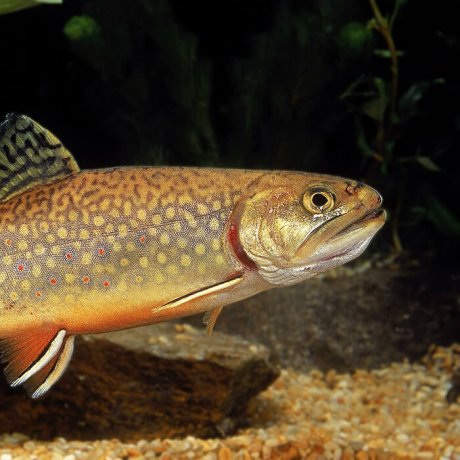
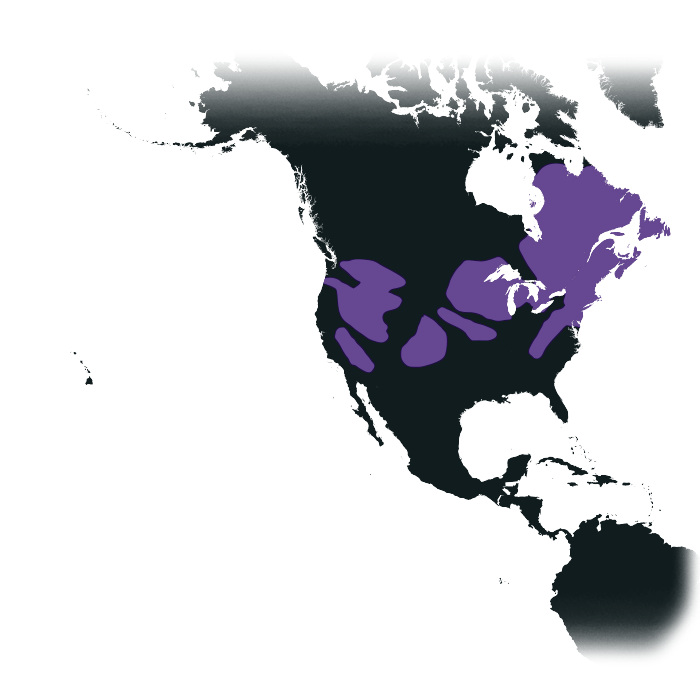
Brook Trout
Salvelinus fontinalis
Our Animals
Around 20 Brook Trout
Size
Typically 10-25 in. (25-65 cm) in body length, 0.6-7 lbs (0.3-3 kg).
Habitat
Cold, flowing, clean water with adequate cover. In our area they are most often found in unpolluted, cold-water streams and rivers, and some lakes.
Conservation Status
Least concern, although their native range and populations have been severely reduced. They have recovered and continue to recover in some areas. Stocking of hatchery-raised fish helps boost populations.
Diet
Opportunistic carnivore- they will eat aquatic and terrestrial (if they fall into the water) insects, crustaceans, mollusks, amphibians, smaller fish, and any other small animals that may enter the water they live in.
Natural History Nuggets
- Beautifully colored and patterned fish, with males having the brightest red-orange bellies.
- Pennsylvania’s only native trout species, all others are introduced.
- Two ecological forms of Brook Trout exist: larger “Coasters” live in large lakes, migrate to streams to breed, and are more predacious of other vertebrates. “Salters” live in coastal marine waters, migrate to streams and rivers to breed, and are smaller and eat smaller invertebrates and fish.
- Brook Trout thrive in cold water (less than 60⁰F) that is fast flowing, and unpolluted. Warmer, still water does not have adequate oxygen for these fish and causes distress.
- One of the most popular and beautiful game fish in North America, they are frequently farmed so that they can be stocked in private and public waterways for fishing.
- Females can lay up to 5,000 eggs at once!
- Commonly eaten by otters.
Conservation Concerns, how you can help!
- Many populations were historically extirpated due to a variety of factors: overfishing, clear-cutting forests around streams, dams, erosion/sedimentation, climate change, competition from invasive species (like introduced Brown and Rainbow Trout), organic and inorganic pollution. Anything that warms water, or reduces habitat or food endangers trout.
- Reintroductions and conservation work restored habitat and helped many populations recover.
- You can help trout by buying a fishing license that helps fund work to improve their populations.
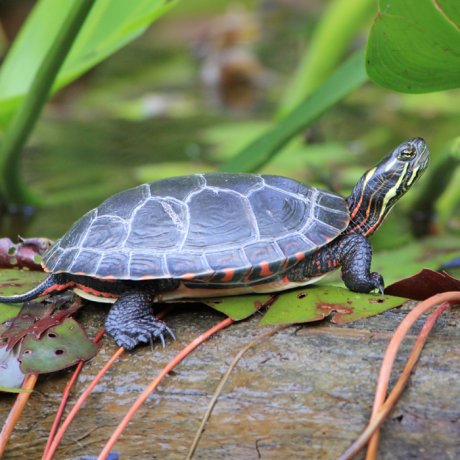
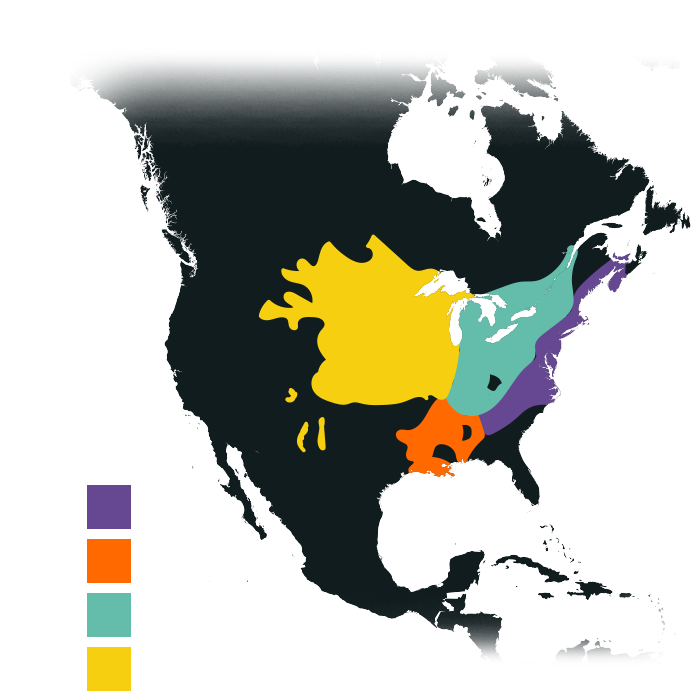
Painted Turtle
Chrysemys picta
Our Animals
Tulpe: Male – Eastern Painted Turtle
Mona: Female – Unknown subspecies
Size
Size: 3-10 in. (7-25 cm), 11-18 oz. (300-500 g)
Habitat
Can be found in most freshwater habitats, but prefers shallow, slow-moving wetland areas like marshes, ponds, and margins of large lakes and rivers.
Conservation Status
Least concern, stable populations. Threats include competition from exotic invasive turtle species, and road mortality.
Diet
Omnivorous – aquatic vegetation, algae, and small aquatic animals, including invertebrates and fish.
Natural History Nuggets
- There are 4 subspecies, 2 of which are found in the Lehigh River Watershed- Eastern and Midland Painted Turtle.
- Named for the colorful pink to orange lines on their skin and the edges of their carapace.
- Aquatic turtles hibernate in the bottoms of the bodies of water they live in, absorbing oxygen through a process called “reverse respiration”.
- They “breathe through their butts”!
- Commonly seen basking on rocks and logs.
- They can live over 50 years.
Conservation Concerns, how you can help!
- Turtles are often hit by cars when crossing roads, you can help them cross safely by moving them to the side of the road that they were facing.
- Red-eared Sliders released into our waterways as unwanted pets are an exotic invasive species that outcompetes Painted Turtles. Never release pets into the wild and never take animals out of the wild to be your pet.
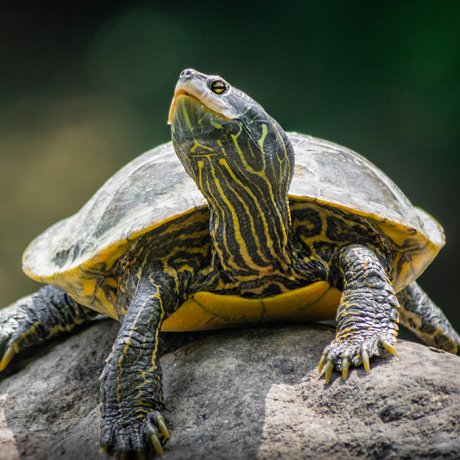
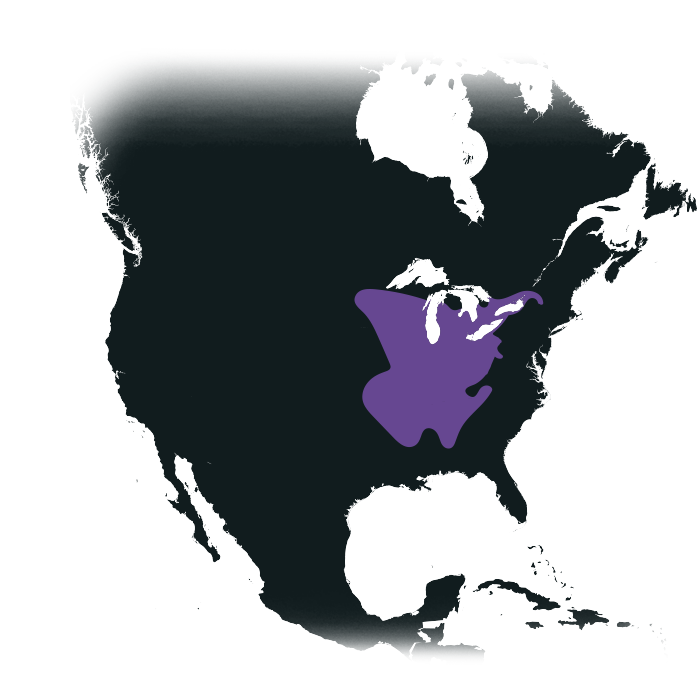
Map Turtle
Graptemys sp.
Our Animals
Atlas, female
Size
5-12 in. (13-30 cm), 1 lb. (0.45 kg)
Habitat
Large lakes and rivers with plentiful rocks and fallen trees for basking.
Conservation Status
Least concern overall, but a species of special concern in Pennsylvania due to habitat loss.
Diet
Omnivorous- Will eat aquatic vegetation, but prefers mollusks, insects, and crustaceans.
Natural History Nuggets
- Named for the yellow lines on its shell and skin which resemble markings on a topographic map.
- Aquatic turtles hibernate in the bottoms of the bodies of water they live in, absorbing oxygen through a process called “reverse respiration”.
- They “breathe through their butts”!
- Commonly seen basking on rocks and logs.
- Female map turtles are often significantly larger than males
Conservation Concerns, how you can help!
- Map turtles are habitat specialists and are easily outcompeted by more adaptable species when their habitat is altered.
- Sensitive to human interference in their habitats from boating.
- Turtles are often hit by cars when crossing roads, you can help them cross safely by moving them to the side of the road that they were facing.
- Red-eared Sliders released into our waterways as unwanted pets are an exotic invasive species that outcompetes Painted Turtles. Never release pets into the wild and never take animals out of the wild to be your pet.
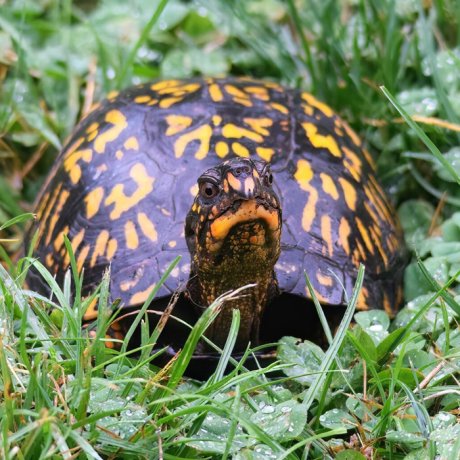
Eastern Box Turtle
Terrapene carolina carolina
Our Animals
Franklin, Tahkox (pronounced “taco”), and Leonardo, all males.
Size
5-8 in. (12-20 cm) 14-21 oz. (400-600 g)
Habitat
Deciduous woodland, meadows/fields, marshy areas- usually in lowlands near a wooded edge
Conservation Status
Populations are declining- IUCN lists them as vulnerable, species of special concern in PA.
Diet
Opportunistic omnivores, feeding on a wide variety of animal and plant matter ranging from fruits and greens to invertebrates and carrion.
Natural History Nuggets
- The Common Box Turtle (Terrapene carolina) is split into several subspecies, four of which occur in North America: Eastern, Florida, Gulf Coast, and Three-toed Box Turtles. Only the Eastern Box Turtles (T. c. carolina) live in our region.
- Box turtles can live over 100 years.
- Box Turtles get their name from their ability to close their hinged plastron (bottom of shell) “tight like a box” to completely protect their legs and head from predators.
- Patterning on their carapace (top of shell) is thought to mimic sunlight scattering through leaves on the forest floor and helps them to camouflage.
Conservation Concerns, how you can help!
- Collection for the pet trade and international food markets, road mortality, habitat loss, and predation of eggs by overpopulated predators are all major threats to Eastern Box Turtles.
- Sensitive to human interference in their habitats from boating.
- Help turtles cross the road by moving them across in the direction they were facing.
- Support land trusts and government agencies who help protect turtle habitat.
- Never remove turtles from the wild.
- If you find box turtles, be careful who you share the location with – do not post locations online.
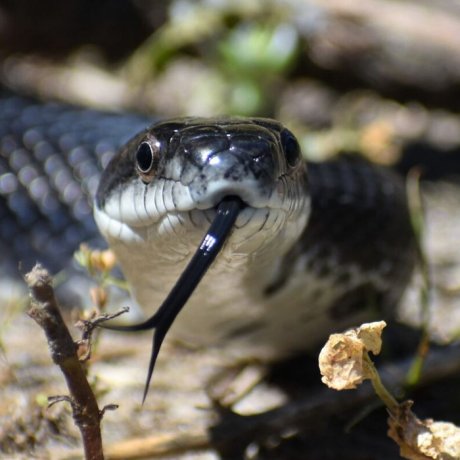
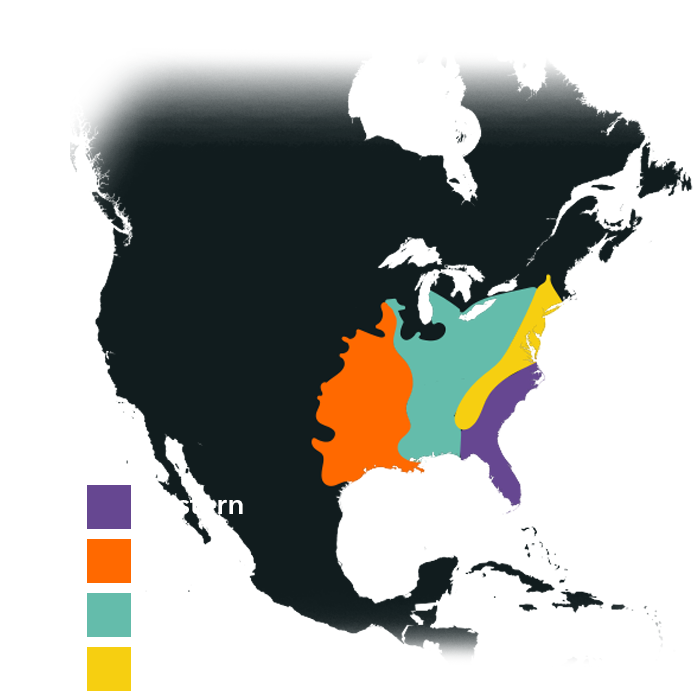
Black Rat Snake
Pantherophis sp.
Our Animals
Spicy Tony, male.
Size
40-101 in. (102-257 cm) long, 1-3 lbs. (500-1500 g).
Habitat
Found in woodland, woodland edge, and meadow habitats. In the Lehigh River watershed, remote, wooded areas with rocky openings, are good places to find this species.
Conservation Status
Least concern, common and widespread in appropriate habitat. Road mortality, habitat loss, and rodenticides are their primary threats.
Diet
Carnivorous, preferring warm-blooded prey. Rodents, other small mammals, birds, and bird eggs are typical prey items. Will sometimes take reptiles and amphibians.
Natural History Nuggets
- Longest snake found in Pennsylvania, reaching lengths of over 8 feet.
- Slender bodied, Timber Rattlesnakes can heavier.
- Eastern, Gray, and Western Rat Snakes are all commonly referred to “Black Rat Snakes”, with the first two species being found in our region.
- Black Rat Snakes are checkered gray and tan as juveniles for their first few years of life, before turning black.
- “Black Snake” is a colloquial term used for various large, dark colored snakes, including black rat snakes, Black Racers, and some Eastern Hognose Snakes, Northern Water Snakes, and Timber Rattlesnakes.
- Black Rat Snakes are highly arboreal and are excellent climbers. Their bodies are shaped like a loaf of bread or suction-cup in cross-section (while most snakes are round), allowing them to scale rather smooth vertical surfaces.
Conservation Concerns, how you can help!
- Avoid using rodenticides, since animals like snakes can eat poisoned mice and become poisoned themselves.
- Drive carefully on rural roads to avoid hitting snakes.
- The greatest thing you can do to help snakes is to help teach people how interesting, beneficial, and fascinating they are!
Birds
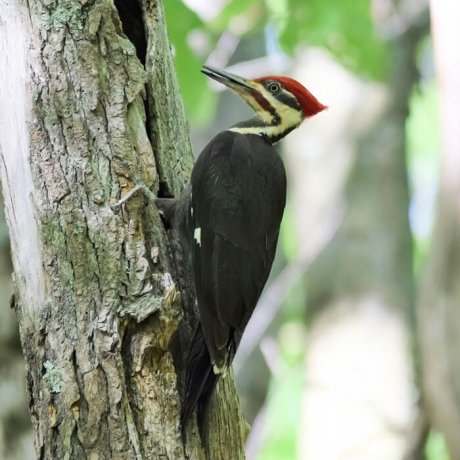
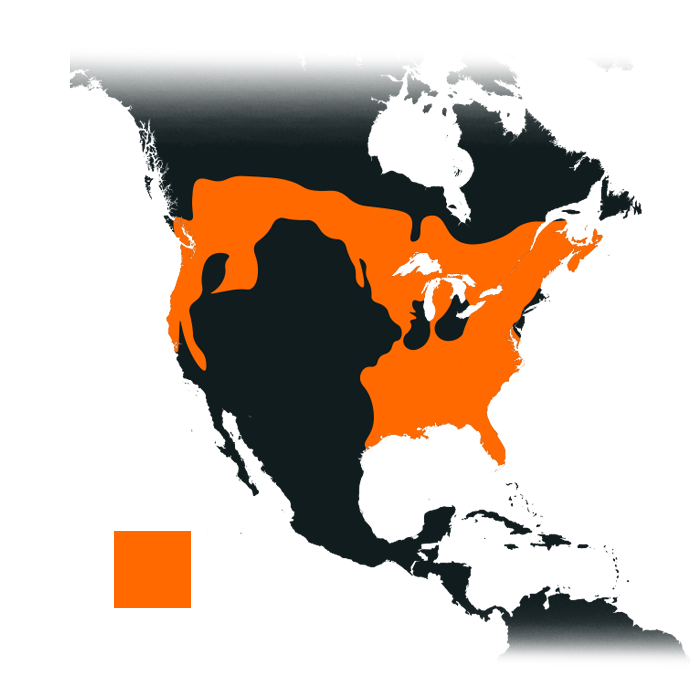
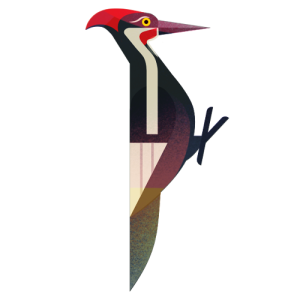
Pileated Woodpecker
Dryocopus pileatus
Size
16-19 in. (40-49 cm), 26-30in (66-75 cm) wingspan, 8-12 oz. (250-350 g)
Habitat
Forests, typically large tracts of older forest with large, standing dead trees. Can be found in many forest types.
Conservation Status
Least concern, populations are steady to increasing in our area. Still, loss of habitat (especially clearing of dead trees) is a threat.
Diet
Primarily wood-dwelling insects like carpenter ants, termites, and beetle larvae. Will also eat fruits and nuts, other insects, and occasionally bird seed and suet.
Natural History Nuggets
- Woodpeckers have many amazing adaptations for extracting insects from dead trees, including a long, barbed tongue used for spearing food. Their tongue doubles as a cushion for pecking trees since it wraps around their skull!
- Pileated Woodpeckers are known for their incredibly loud jackhammer-like drumming, as well as their loud, exotic-sounding calls.
- Males have a red “malar stripe” behind their beaks, while in females this is black.
- Pileated Woodpeckers make large, square holes in trees, differentiating their excavations from other species’.
Conservation Concerns, how you can help!
- You can help woodpeckers by not cutting down dead trees which are not hazardous, or even by leaving several feet of tree stump for them to excavate.
- You can help all birds by keeping cats indoors.
- You can help all birds by protecting your windows from bird collisions.
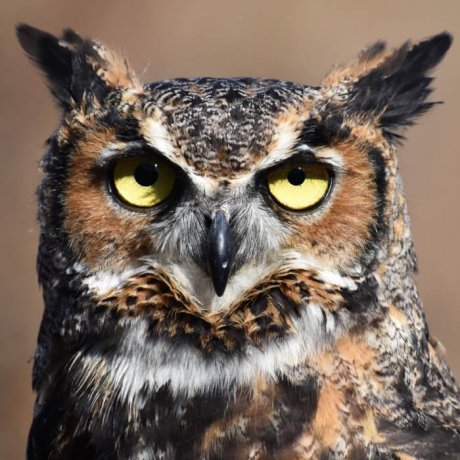
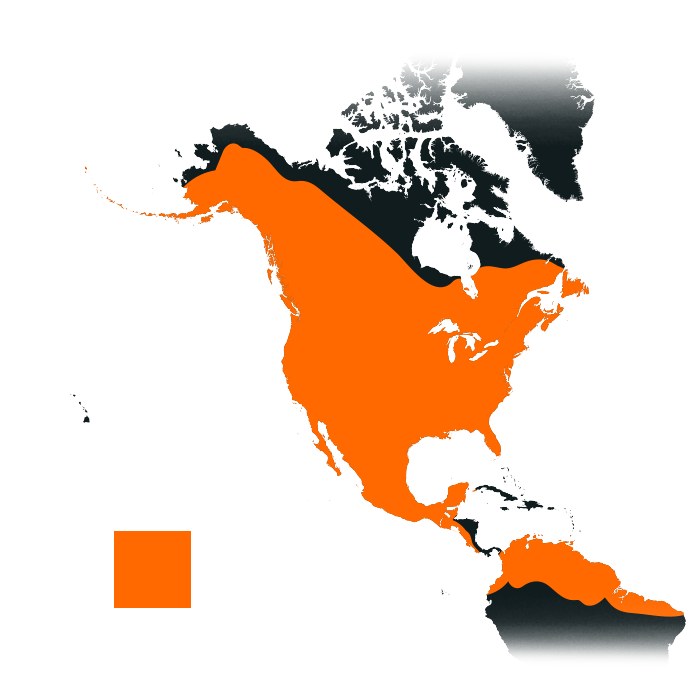

Great Horned Owl
Bubo virginianus
Size
18-25 in. (46-63 cm), 40-57 in. (101-145 cm) wingspan, 2-5.5 lbs. (900-2500 g).
Habitat
Habitat generalists, preferring forests with nearby fields or other open areas. Fairly common in urban and suburban parks as well.
Conservation Status
Least concern, common throughout most of their range. Very adaptable if food is available. Threats include vehicle collisions, rodenticides, and West Nile Virus (made more common by climate change).
Diet
Most diverse diet of any North American raptor. Anything that they can kill can be prey. Most common prey are small-medium sized mammals, like rodents and rabbits, and smaller birds. Prey has included insects, skunks, geese, other birds of prey, herons, snakes, bats, house cats, porcupines, loons, fish, and even carrion.
Natural History Nuggets
- These powerful owls are apex predators in our region, having no common predators of their own as adults.
- While most owls don’t make a classic “hoot”, Great Horned Owls do, they sound exactly like what you think an owl would sound like.
- Males are smaller in body size but have a deeper 6–7-part hoot, while females are larger and have a higher pitched, shorter series of hoots.
- Great Horned Owls have sharp talons and powerful feet that can squeeze many times harder than our hands.
Conservation Concerns, how you can help!
- You can help owls by avoiding use of rodenticides for controlling pests.
- Do not throw food scraps on roadways, as it can attract prey animals for owls and other raptors, and both predator and prey can be hit by cars.
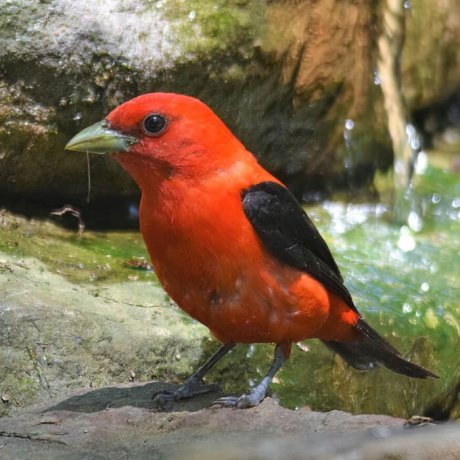
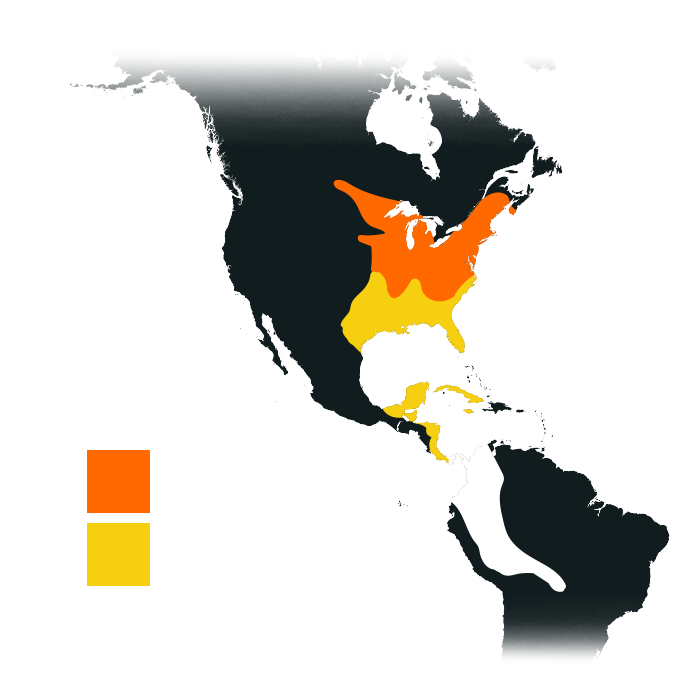
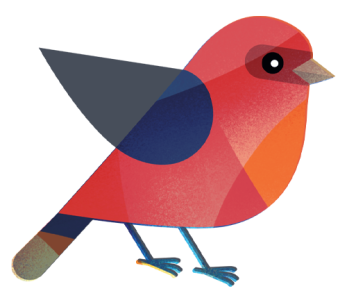
Scarlet Tanager
Piranga olivacea
Size
6 in. (15 cm), 9-11 in. (23-28 cm) wingspan, 1 oz (28 g).
Habitat
Deciduous and mixed coniferous-deciduous forest, prefers large, undisturbed forest tracts.
Conservation Status
Least concern, populations are steady in our area, however forest fragmentation is a threat to their populations.
Diet
Insects and fruit.
Natural History Nuggets
- Male Scarlet Tanagers have brilliant red body plumage and jet-black wings. Females, non-breeding males, and young birds have yellow body plumage.
- Despite their flashy colors, they prefer to stay in the forest canopy and are more often heard than seen.
- Their call is a harsh and very recognizable “Chick-Burr”.
Conservation Concerns, how you can help!
- You can help Scarlet Tanagers by leaving forested land intact and supporting land trusts who protect forests.
- You can help all birds by keeping cats indoors.
- You can help all birds by protecting your windows from bird collisions
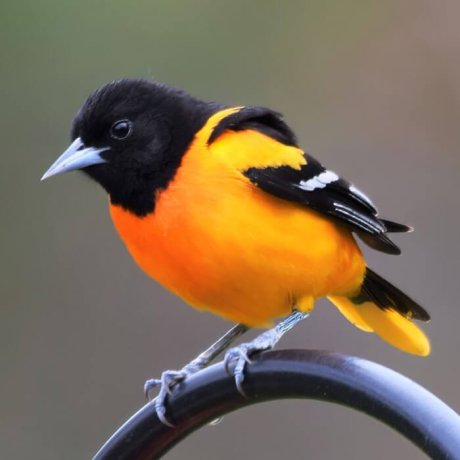
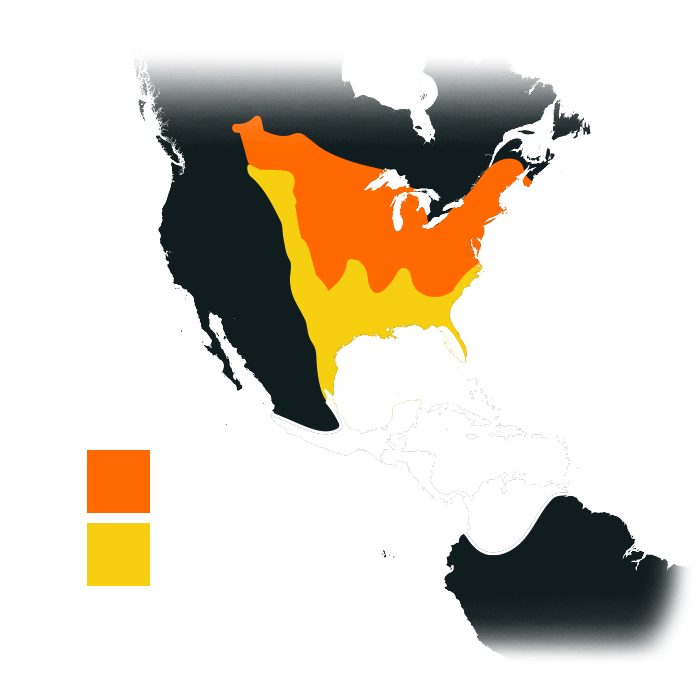
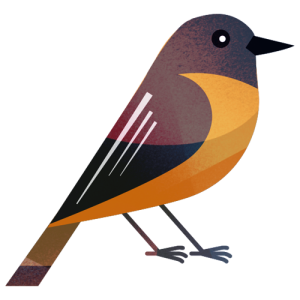
Baltimore Oriole
Icterus galbula
Size
7 in. (18 cm), 9-12 in. (23-30 cm) wingspan,1 oz (28 g).
Habitat
Leafy deciduous trees, typically in open woodland or forest edges.
Conservation Status
Abundant and widespread, but populations have declined by over 30% since the 1960’s. Habitat loss, insecticides, and window collisions are all large sources of mortality.
Diet
Insects, fruits, and nectar.
Natural History Nuggets
- Male Baltimore Orioles are strikingly bright orange and black, while females are more of a yellow-orange
- Despite their flashy colors, orioles are often found in the canopy and are more often heard than seen.
- Orioles will often come to bird feeders for oranges and jelly.
- This species is the state bird of Maryland and the namesake for the Baltimore Orioles baseball team.
Conservation Concerns, how you can help!
- You can help Baltimore Orioles by using less pesticides to kill insects.
- You can help all birds by keeping cats indoors.
- You can help all birds by protecting your windows from bird collisions.
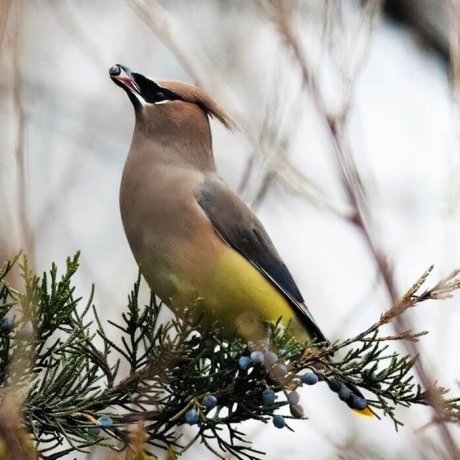
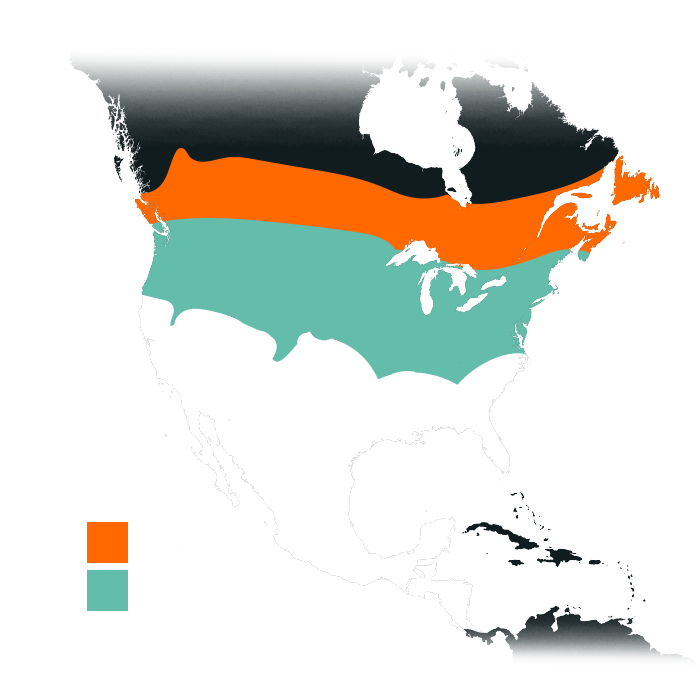
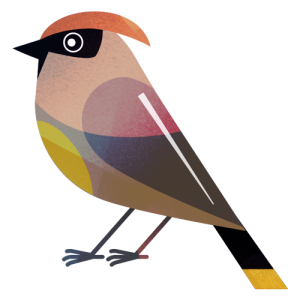
Cedar Waxwing
Size
6 in. (15 cm), 9-11 in. (25-29 cm) wingspan,1 oz (28 g).
Habitat
Nomadically follow fruit, can be found wherever good berry crops are present. Nest in nearly any forest type.
Conservation Status
Least concern, populations are steady to increasing in our area due to old agricultural fields reverting to more berry-rich forest. Window and vehicle collisions are threats.
Diet
Primarily fruit, year-round. In the summer they may supplement their diet with flying insects for protein.
Natural History Nuggets
- With their black mask, silky plumage, crest, and touches of bright yellow and red, Cedar Waxwings are understatedly stunning birds.
- Their name is derived from both one of their favorite foods (Cedar/Juniper berries), and from the red tips to some of their wing feathers, which look like the wax used to seal envelopes.
- Their call is an ear-piercing high pitched single note.
- Their yellow tail tips can turn orange or reddish depending on the pigment in the fruits that they eat.
- Cedar Waxwings can congregate in large flocks around a good fruit source.
Conservation Concerns, how you can help!
- You can help Cedar Waxwings by planting native, fruit-bearing plants.
- You can help all birds by keeping cats indoors.
- You can help all birds by protecting your windows from bird collisions.
Insects
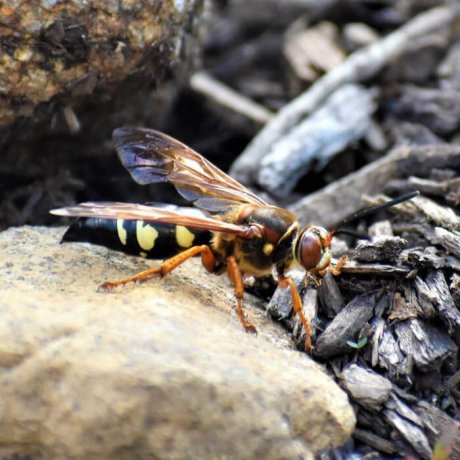
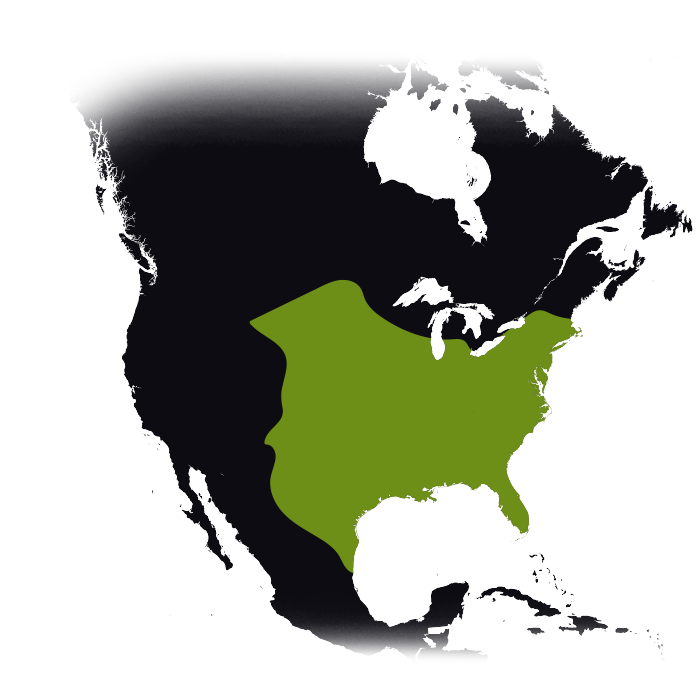
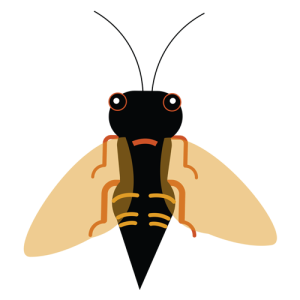
Eastern Cicada Killer Wasp
Sphecius speciosus
Size
Up to 2 in. (5 cm) long.
Habitat
Habitat generalist, requiring only nearby trees with cicadas, flowering plants, and loose, sandy soil for burrowing/nesting.
Conservation Status
Least concern due to its ability to adapt well to life around humans.
Diet
Adults feed on flower nectar and plant sap. Females lay eggs in Cicadas, which they paralyze by stinging. Larvae feed on Cicadas.
Natural History Nuggets
- This is one of the largest wasp species found in North America.
- Despite their intimidating appearance, Cicada Killer Wasps are non-aggressive and rarely sting.
- These wasps help trees by controlling cicada populations, as cicadas feed on trees.
- Males establish territories by challenging each other to aerial fights and may even bump into humans, but thankfully, male wasps, hornets, and bees are not capable of stinging.
Conservation Concerns, how you can help!
- You can help insects by reducing the use of insecticides.
- You can help bees and wasps by respecting them as important pollinators, and by giving them space.
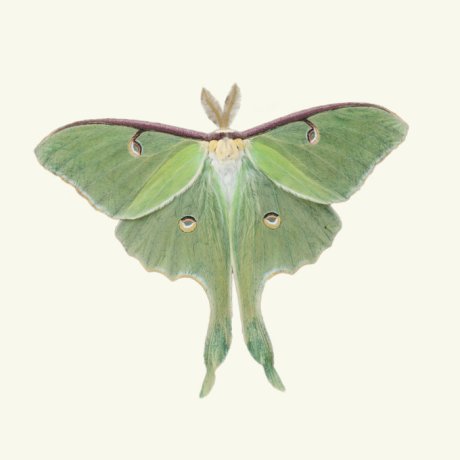
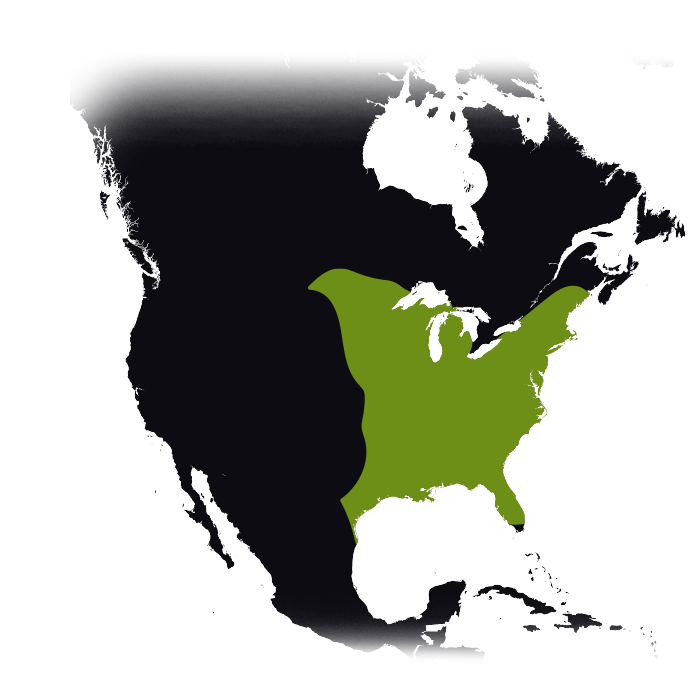
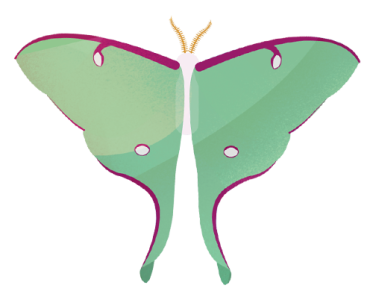
Luna Moth
Actias luna
Size
Up to a 7 in. (18 cm) wingspan as adults, caterpillars can be 3.5 in. (9 cm) long.
Habitat
Forests containing their host plants: most commonly birches, Persimmon, Sweet Gum, hickories, Black Walnut, and Sumac.
Conservation Status
Least concern, populations are stable.
Diet
Larvae (caterpillars) feed on leaves of the tree species listed above. Adults do not eat.
Natural History Nuggets
- This is one of the largest moth species found in North America.
- Males can be identified by their feathery antennae, which are used to sense female pheromones from long distances.
- As with many of the “giant silk moths” (Family Saturniidae), adults live for only a week or two, and do not have a digestive system, their sole purpose is to mate and lay eggs.
Conservation Concerns, how you can help!
- You can help insects by reducing the use of insecticides.
- You can help butterflies and moths by planting only native plants.
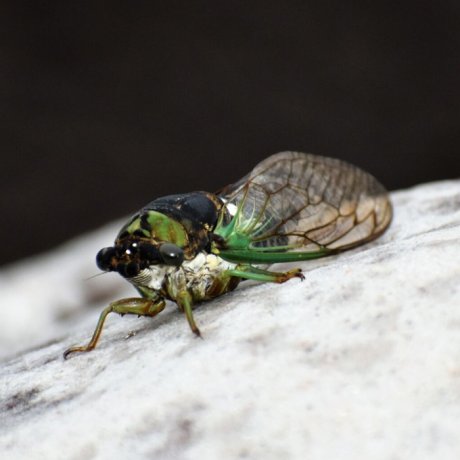
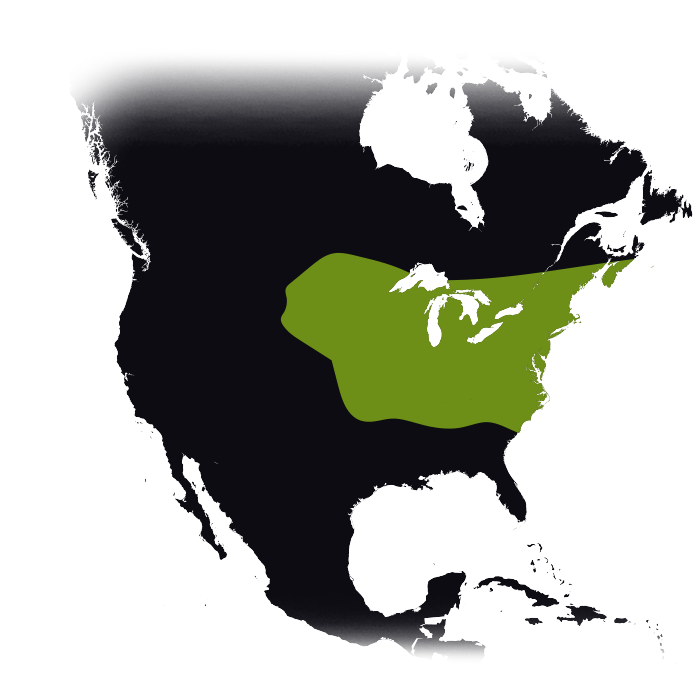
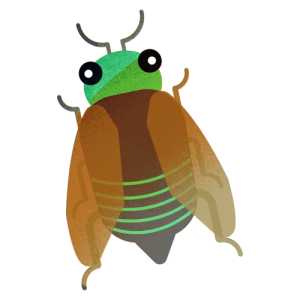
Dog Day Cicada
Neotibicen canicularis
Size
Up to a 7 in. (18 cm) wingspan as adults, caterpillars can be 3.5 in. (9 cm) long.
Habitat
Deciduous and mixed deciduous-coniferous forests.
Conservation Status
Least concern, populations are stable.
Diet
Plant saps and juices- of roots as juveniles, and of branches/stems as adults.
Natural History Nuggets
- Juvenile cicadas (wingless nymphs) spend multiple years underground, feeding on tree roots, before emerging as winged adults.
- Cicadas are famous for their loud calls, and this species has a long, droning call made in the “dog days” of mid-late summer which gives it its name.
- This species has adults that emerge every year, making it an “annual cicada”. Some species, known as “periodic cicadas” have populations that emerge only once every many years, like the famous 17-year cicadas.
- Cicadas emerge in large numbers, making them an excellent food source for breeding birds and other wildlife.
Conservation Concerns, how you can help!
- You can help insects by reducing the use of insecticides.
- You can help cicadas by planting only native plants.
Mammals
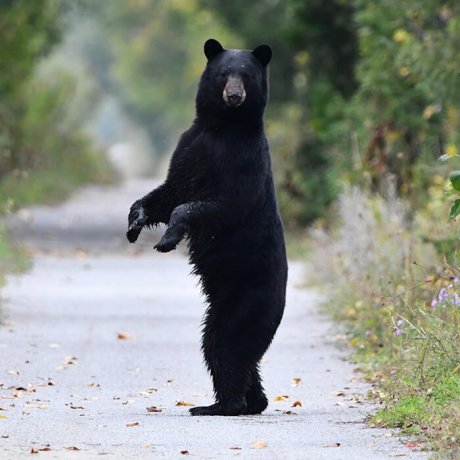
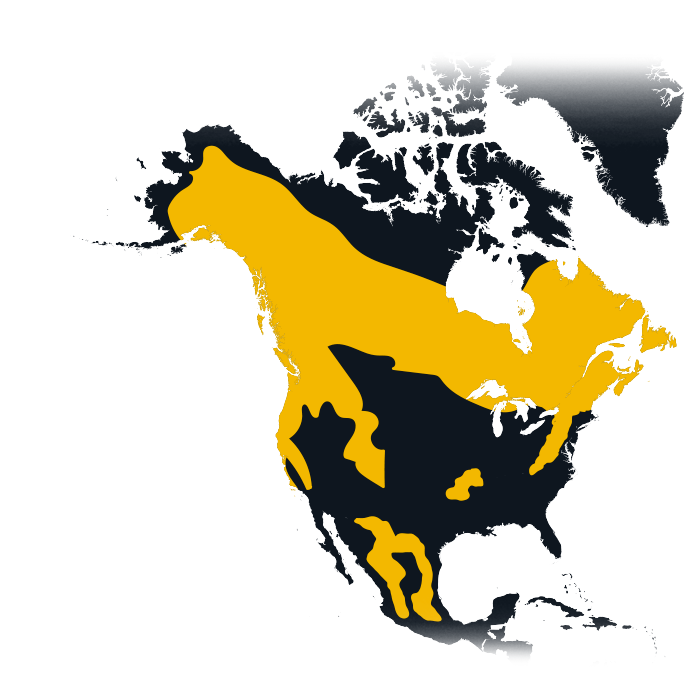

American Black Bear
Ursus americanus
Size
4-6.5 ft. (1-2 m) in body length, 90 to over 500 lbs (40-250+ kg).
Habitat
Prefer areas of thick vegetation and rugged terrain, in various habitats. Are often found in developed areas that border thick forest.
Conservation Status
Least concern, they are the world’s most widely distributed bear species. Although their historical range is much reduced to urbanization and habitat loss.
Diet
Highly opportunistic omnivores, that will eat practically anything edible. Most of their diet consists of vegetation, fruits, and nuts, but will also eat carrion, insects, fish, other small-medium sized animals, human trash, and more.
Natural History Nuggets
- Black Bear is the species, but not necessarily the color, as Black Bears can sometimes be blonde, light to dark brown, and even a silver-gray.
- American Black bears are highly efficient hibernators, dropping their heart rate down to 5x slower than normal as they conserve energy during the cold winter months.
- Some bears will stay active all winter if food is abundant.
- Black bears enter a state of “hyperphagia” in the fall where they are ravenous and gain up to 4lbs per day before hibernation.
- Bears may have the best sense of smell of any animal, being able to follow smells in the air for many miles.
Conservation Concerns, how you can help!
- Black Bears are mostly absent from developed regions of the Lehigh River Watershed due to habitat loss- protecting habitat by supporting land trusts is one of the best ways to help conserve their populations.
- If you live in areas with bears, learn to coexist by securing your garbage, removing bird feeders, and securing or eliminating any other source of food, rather than persecuting and removing the bears.
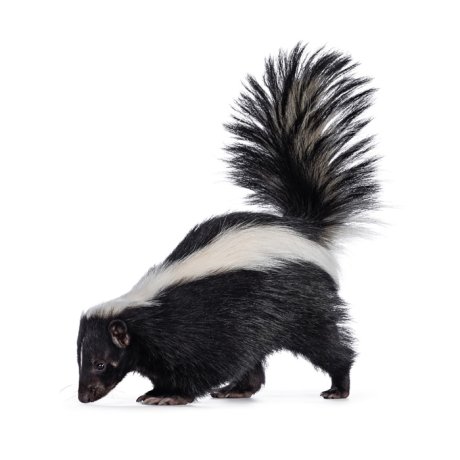
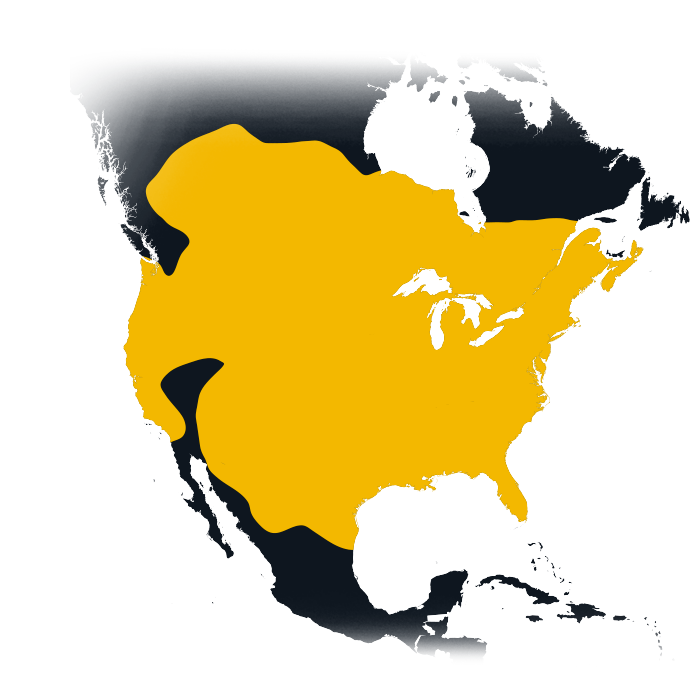
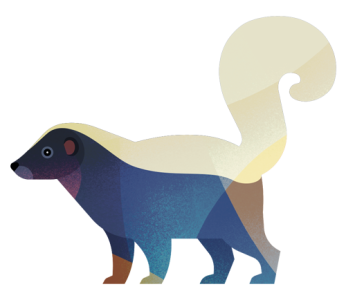
Striped Skunk
Mephitis mephitis
Size
20-30 in. (52-77 cm) in body length, 4-10 lbs (2-4.5 kg)
Habitat
Habitat generalist, commonly living in cities and suburbia, mixed woodlands, brushy edges, and open fields.
Conservation Status
Least concern, due to their ability to adapt to life around humans. Commonly hit by cars.
Diet
Opportunistic omnivores. Primarily insectivorous, but will eat anything, from plant matter to human refuse, to small animals and carrion.
Natural History Nuggets
- Skunks are notorious for their primary defense mechanism- spraying a noxious compound from paired scent glands near their tail, meant to stun and ward off would-be predators.
- They are mainly nocturnal to crepuscular (active during twilight). Skunks seen during daylight hours in summer are most often mothers feeding young.
- Striped skunks are usually black with two white stripes, but this is highly variable, with stripes varying in thickness (often appearing as just one stripe), and color ranging from white, to brown, to black.
- Skunks are great to have around for pest control and can often be seen digging in lawns for beetle grubs that eat the roots of grass.
Conservation Concerns, how you can help!
- One of the easiest ways to help protect scavenging animals like skunks is to not throw food scraps onto roadways. Keep a trash bag in your car instead and save animals from being hit by vehicles!
- Avoid using rodenticides, since animals like skunks can eat poisoned mice and become poisoned themselves.

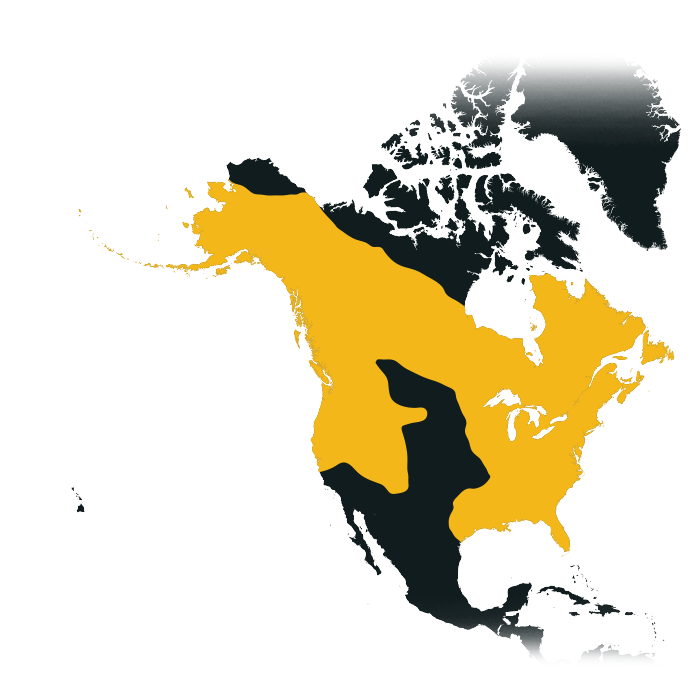
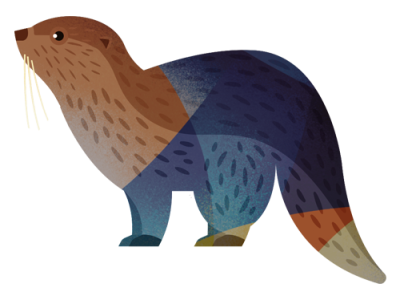
North America River Otter
Lontra canadensis
Size
30 to 60 in. (76-152 cm), with about 1/3 of that being tail. 11-30 lbs (5-14 kg)
Habitat
Nearly any freshwater or coastal wetland habitat including rivers and streams, lakes, marshes, swamps, estuaries, etc. Require unpolluted water, rich with food.
Conservation Status
Least concern, expanding range and now thriving again in the Lehigh River Watershed. Populations declined heavily, historically, but are recovering.
Diet
Omnivorous but prefer fish and aquatic invertebrates. Will also eat other small animals, vegetation.
Natural History Nuggets
- Otters spend 75% of their time on land, usually sleeping near the water’s edge.
- North American River Otters are the largest weasel species found in Pennsylvania.
- River otters can dive up to 60 feet deep and hold their breath for several minutes.
- Otters love to play, which reinforces social bonds and hones hunting skills.
Conservation Concerns, how you can help!
- Otters declined severely by the early 1900s due to over-trapping for their fur, which was coveted by people. Reintroductions and habitat restoration have helped them rebound.
- Water pollution and loss of wetland habitat are current threats.
- You can help them by cleaning up trash around roadways, using less road salt in winter, and planting native plants in wetlands and near streams.
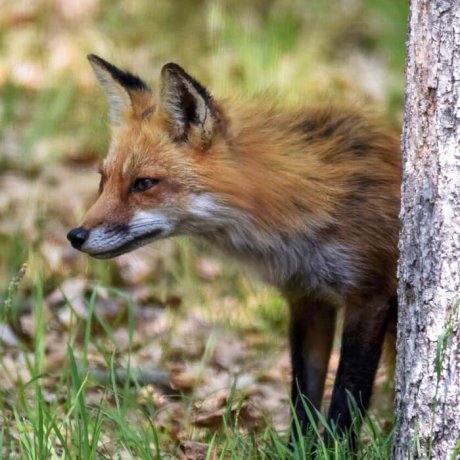
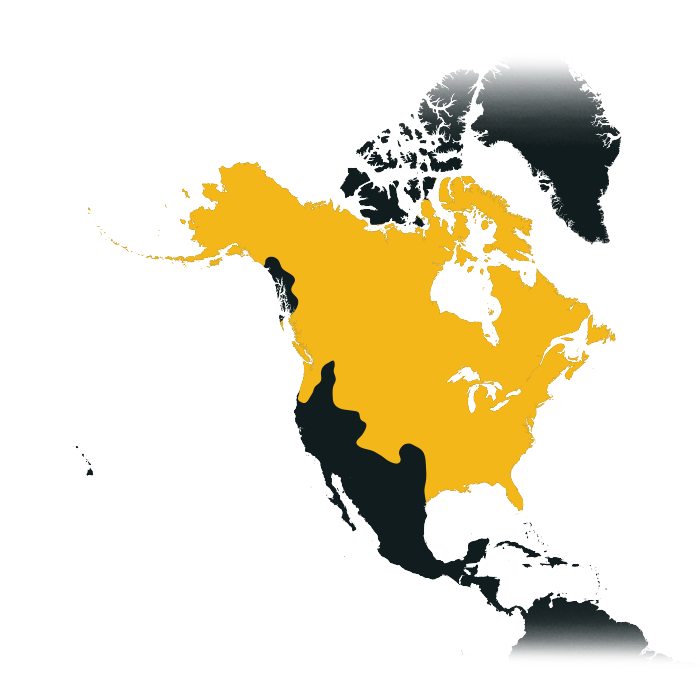
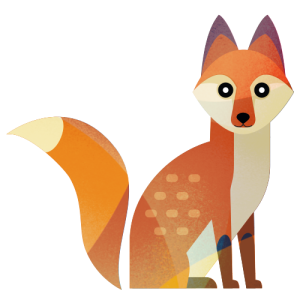
Red Fox
Vulpes vulpes
Size
18-35 in. (45-90 cm) in body length, 5-30 lbs (2-14 kg).
Habitat
Habitat generalist, found in many habitats, nearly worldwide. In our area, forest edges, fields, and suburban areas are common habitats.
Conservation Status
Least concern, due to their ability to adapt to life around humans. Commonly hit by cars.
Diet
Opportunistic omnivores who primarily feed on small rodents, but will eat birds, reptiles, rabbits, insects, and a variety of plant matter including fruits, grasses, tubers, and nuts.
Natural History Nuggets
- Red Foxes are thought to have naturally expanded their range from western to eastern North American as they adapted to the increasing human population.
- Red Fox is a destructive exotic-invasive species in Australia.
- While most commonly a beautiful red-orange color, this species can be black or a silver-gray.
- While they can contract and spread rabies, foxes active during the day are most likely mothers looking for food for their hungry kits.
- Red Foxes have been domesticated, similarly to dogs, in some parts of the world.
Conservation Concerns, how you can help!
- One of the easiest ways to help protect animals like foxes is to not throw food scraps onto roadways. Keep a trash bag in your car instead and save animals from being hit by vehicles!
- Avoid using rodenticides, since animals like foxes can eat poisoned mice and become poisoned themselves.
- Commonly persecuted as livestock pests and trapped for their pelts. You can help them by encouraging people to coexist with foxes and other wildlife.
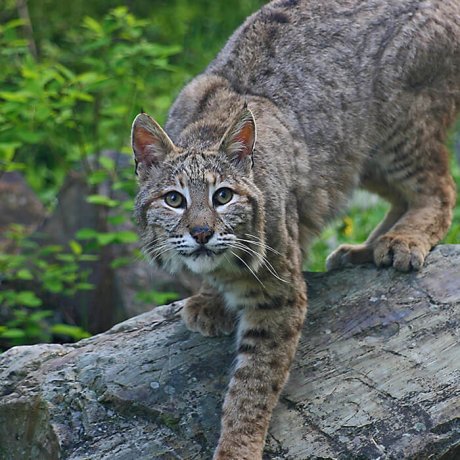
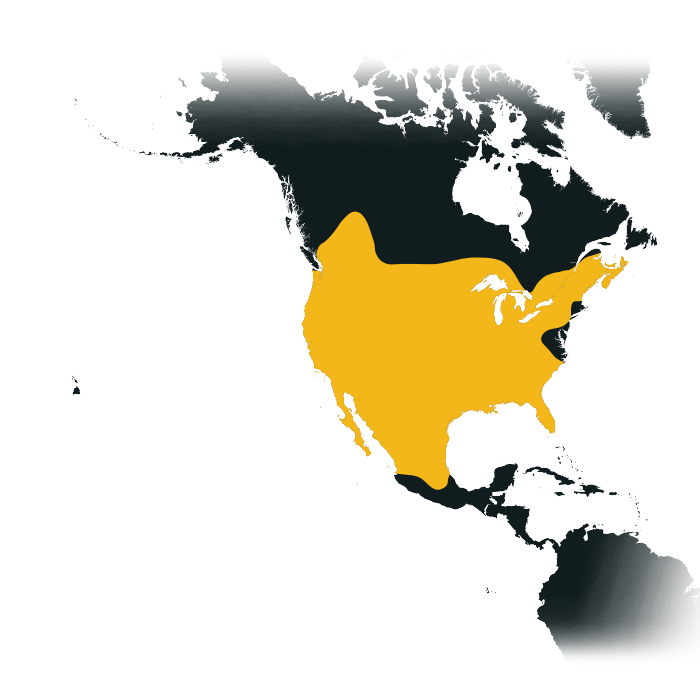
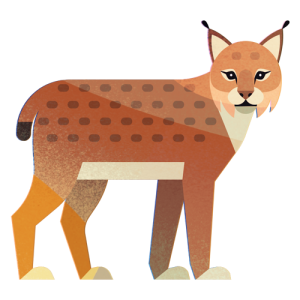
Bobcat
Lynx rufus
Size
18-50 in. (47-125 cm) in body length, 10-40 lbs (4.5-18 kg).
Habitat
Habitat generalist, usually found in remote areas near clearings. Can be found in forests, mountainous habitat, swamps, agricultural areas, and more.
Conservation Status
Least concern but does not adapt well to development in our region. Historically persecuted, populations have recovered recently.
Diet
Carnivores and opportunistic predators who will prey upon a large variety of small animal species. Rabbits are their most common prey, but will also prey upon rodents, other mammals, birds, reptiles, amphibians, fish, insects, and small domestic animals. Will also eat carrion
Natural History Nuggets
- The only native feline found in Pennsylvania.
- Also called the swamp tiger.
- Extremely athletic animals who use their muscular hind-legs to jump up to 10 feet.
- Excellent senses of sight, hearing, and smell aid in hunting.
- Territories can be up to 40 square miles.
- Mainly nocturnal but sometimes will be active during the day.
- Named for its stubby tail.
- Very secretive and stealthy animals who are not often seen.
Conservation Concerns, how you can help!
- Support land trusts who protect bobcat habitat.
- Avoid using rodenticides, since animals like bobcats can eat poisoned mice and become poisoned themselves.
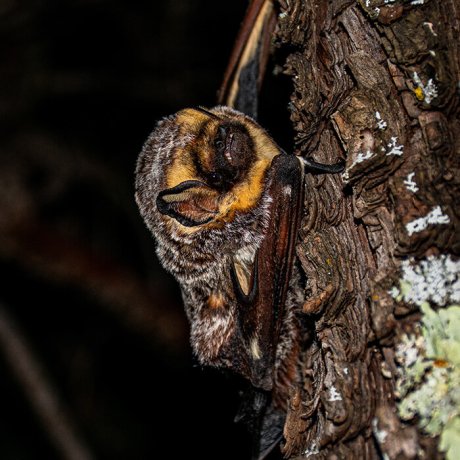
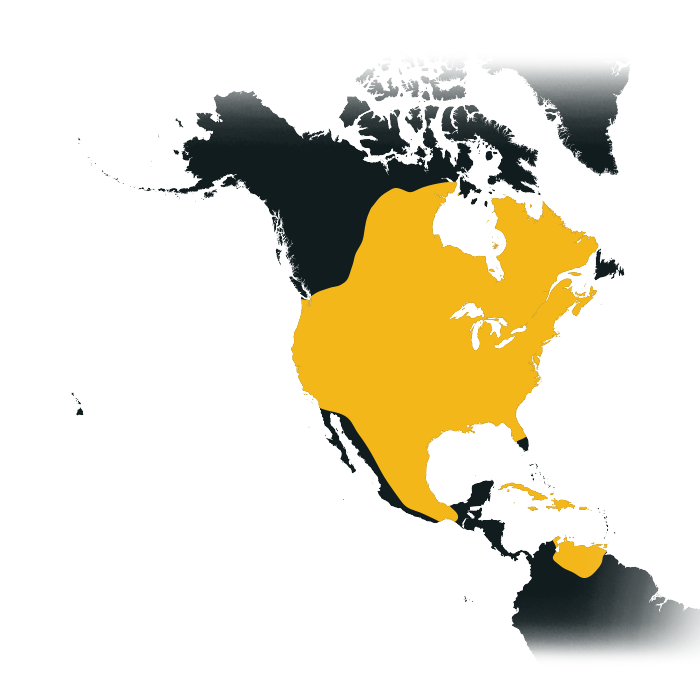
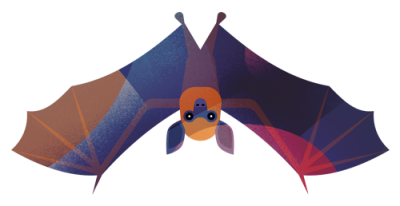
Hoary Bat
Lasiurus cinereus
Size
5 in. (13 cm) in body length, 15 in. (38 cm) wingspan, weighs less than 1 oz (28 g).
Habitat
Forests, prefers to roost in coniferous forests and hunt over open areas or lakes.
Conservation Status
Listed as least concern, but populations may be declining due to collisions with wind turbines and declining flying insect populations.
Diet
Large flying insects, mostly moths.
Natural History Nuggets
- 1 of 3 migratory, tree-roosting bat species in Pennsylvania
- The Lehigh River Watershed’s largest bast species.
- Long-distance migrants, spending their summers in the northeast United States, and their winters in Central America.
- Pennsylvania has 9 species of bats, and all eat insects, making them great pest control.
- 6 native bat species hibernate in caves or buildings, 3 migrate.
Conservation Concerns, how you can help!
- Bats need our help, they are a vital part of the ecosystem, and are struggling.
- Hibernating species are suffering from White-nose Syndrome, an invasive fungal disease.
- Migratory species are declining due to collisions with wind turbines.
- All are facing a declining flying insect population.
- Put up bat houses to give bats a safe place to roost.
- Limit or eliminate the use of insecticides.
- Demand that the wind energy industry make equipment bat and bird safe.
Reptiles & Amphibians
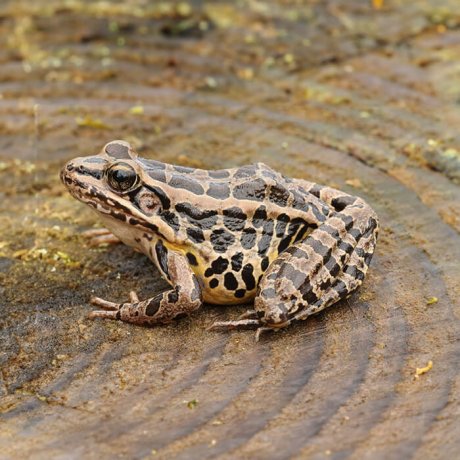
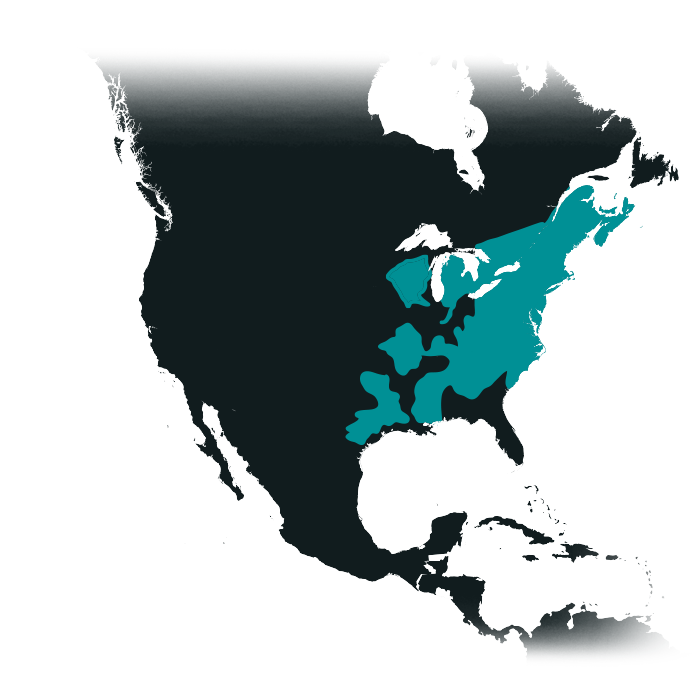
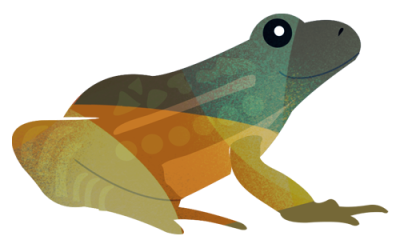
Pickerel Frog
Lithobates palustris
Size
2-3 in. (5-8 cm) in body length.
Habitat
A variety of aquatic habitats, including streams, rivers, lake edges, bogs, and other wetlands. Require unpolluted water.
Conservation Status
Least concern, although all amphibians are pollution sensitive.
Diet
Invertebrates, mostly insects and spiders.
Natural History Nuggets
- Pickerel frogs are very athletic jumpers and have bright orange patches on their inner thighs, which are meant to startle predators
- The pickerel frog call is a comical grunting noise.
- Pickerel frog tadpoles metamorphose to froglets after about 3 months.
- Some frog species, like American Bullfrogs, can stay in their tadpole stage for multiple years.
Conservation Concerns, how you can help!
- Drive carefully and slowly on warm rainy nights, especially in spring, as this is when many amphibians cross roads and are hit by vehicles.
- Easy actions like using less road salt and making sure your vehicles are maintained and not leaking chemicals can help keep our waterways cleaner for pollution-sensitive frogs.
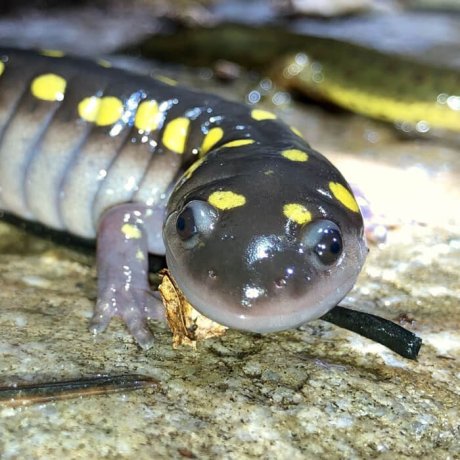
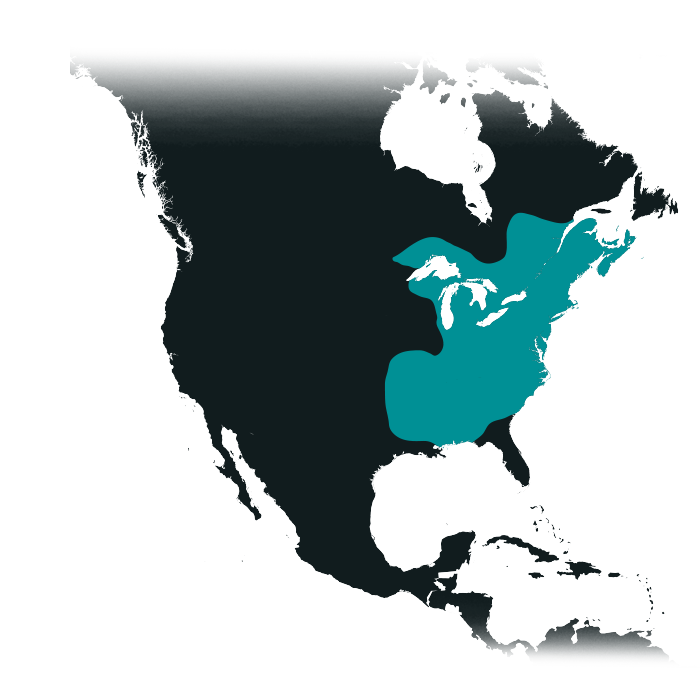
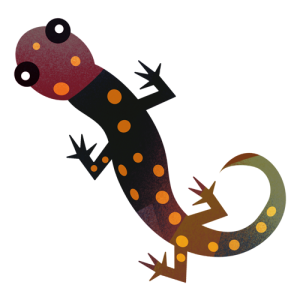
Spotted Salamander
Ambystoma maculatum
Size
6-10 in. (15-25 cm) in body length.
Habitat
Mature forest with dense canopy cover and ephemeral/vernal pools.
Conservation Status
Least concern. Road mortality and pollution are threats.
Diet
Mostly ground-dwelling invertebrates as adults and aquatic invertebrates as larvae.
Natural History Nuggets
- Spotted Salamanders are part of Ambystomatidae or the “mole salamander” family.
- These salamanders spend most of their adult lives underground, except for the first few warm and rainy nights each spring (or late winter) when they emerge to migrate to mating pools.
- They mate and lay eggs in temporary pools that form from snowmelt/rain on the forest floor, called vernal or ephemeral pools.
- Hundreds of individuals can cover the forest floor during migrations.
- Our largest extant, terrestrial salamander.
- Tiger Salamanders are larger but extirpated from Pennsylvania.
- Spotted Salamanders are technically photosynthetic, having a photosynthetic microorganism that lives in their cells.
- This means they are one of the few animals that can produce energy from sunlight like a plant.
Conservation Concerns, how you can help!
- Drive slowly and carefully on warm rainy nights in late winter/early spring.
- Easy actions like using less road salt and making sure your vehicles are maintained and not leaking chemicals can help keep our waterways cleaner for pollution-sensitive salamanders.

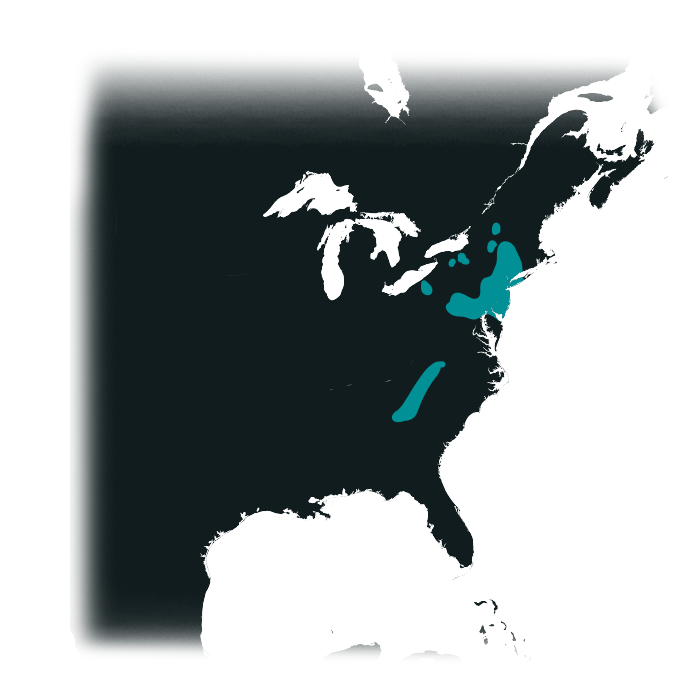
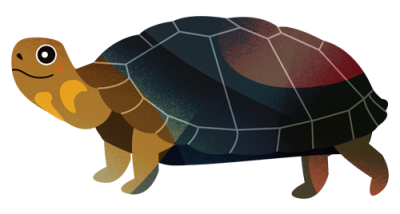
Bog Turtle
Glyptemys muhlenbergii
Size
3-4 in. (8-10 cm) in body length, 4 oz (110 g).
Habitat
Calcareous (alkaline, lime-rich) wetlands, including wet meadows, bogs, marshes, and seeps with both wet and dry habitat.
Conservation Status
Critically Endangered by collection, and by habitat loss due to invasive plants and development. A federally endangered species.
Diet
Omnivorous, feeding on aquatic plants, berries, a variety of invertebrates, and small vertebrates like frogs. Insects are generally their most important food item.
Natural History Nuggets
- Bog Turtles are one of the rarest, most endangered animals in our region, but have a few stable populations on several protected properties in the Lehigh Valley and Pocono regions.
- Bog turtles have many predators, including Northern Water and Common Garter snakes, and mammalian meso-predators (Striped Skunk, Virginia Opossum, Racoons, and Red and Gray Foxes).
- They are semi-aquatic, spending significant amounts of time on land and in water.
- They are a small, cute, and colorful turtle species, with characteristic orange neck markings.
- Good conservation science, including meticulous population surveying and habitat preservation and restoration work, is slowly helping some populations rebound.
Conservation Concerns, how you can help!
- You can help bog turtles by supporting conservation groups who are working to protect their habitats.
- Plant native plants to help these and many other animal species thrive.
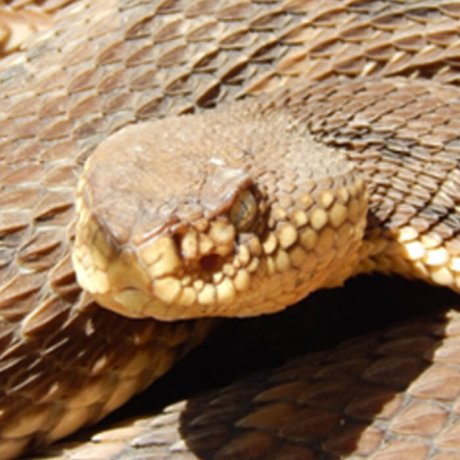
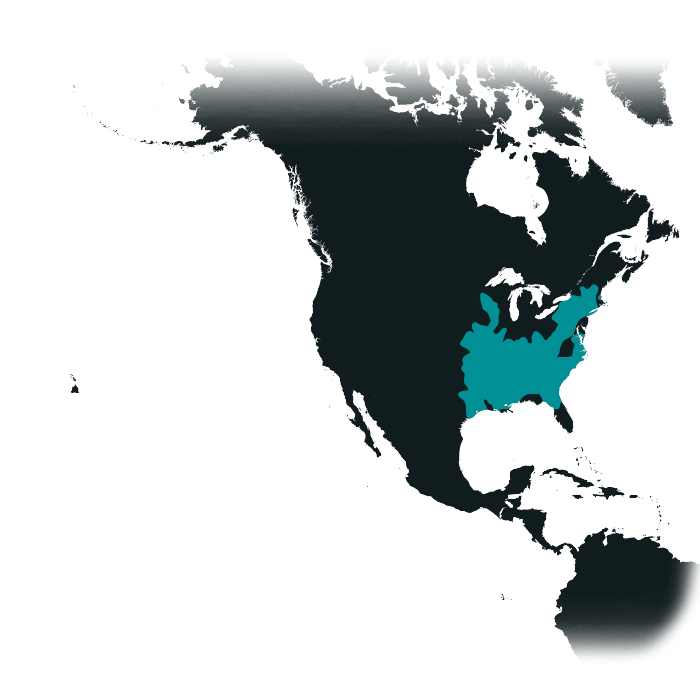
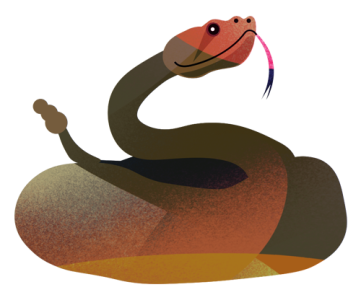
Timber Rattlesnake
Crotalus horridus
Size
3-5 ft. (about 1-1.5 m) in body length, 1-3 lbs (500-1500 g).
Habitat
Rugged terrain in remote deciduous forest. In our region, they are most often found in mountainous areas on or near southern-facing rocky slopes.
Conservation Status
Least concern, species of special concern in Pennsylvania.
Diet
Carnivores who mostly eat rodents. May also prey on other small mammals, birds, amphibians, and reptiles.
Natural History Nuggets
- One of two dangerously venomous snake species in our region, a bite from a Timber Rattlesnake is life-threatening.
- Northern Copperheads live in similar habitats and are also dangerously venomous.
- Thankfully this species is not found in populated areas, and is rather docile, often refusing to bite unless heavily provoked.
- Rattlesnakes will warn predators and other threats by rattling before striking.
- Rattlesnakes and other Vipers give live birth to young.
- Timber Rattlesnakes and several other snake species will often hibernate together in optimal areas, called hibernacula.
- This species can be several different colors, including a yellow-tan, black, and a black and orange “Halloween” color phase.
- Benjamin Franklin advocated for the Timber Rattlesnake rather than the Bald Eagle to be our national symbol, since they defend themselves fiercely but will never start a fight.
Conservation Concerns, how you can help!
- Timber Rattlesnakes were once thought to be endangered but recent conservation work has shown them to have healthy populations in the Lehigh River Watershed and nearby regions.
- Avoid using rodenticides, since animals like snakes can eat poisoned mice and become poisoned themselves.
- Drive carefully on rural roads to avoid hitting snakes.
Fish

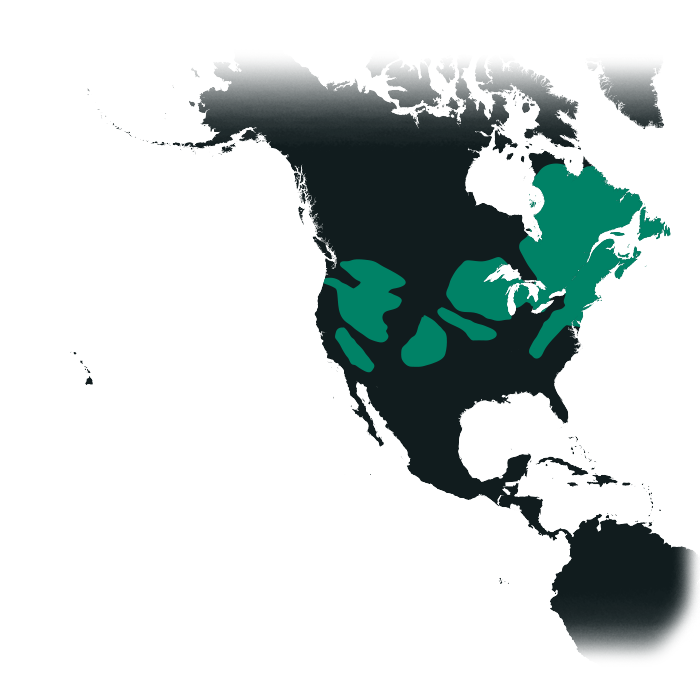
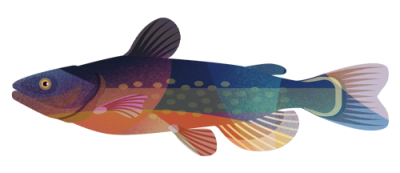
Brook Trout
Salvelinus fontinalis
Size
Typically 10-25 in. (25-65 cm) in body length, 0.6-7 lbs (0.3-3 kg).
Habitat
Cold, flowing, clean water with adequate cover. In our area they are most often found in unpolluted, cold-water streams and rivers, and some lakes.
Conservation Status
Least concern, although their native range and populations have been severely reduced. They have recovered and continue to recover in some areas. Stocking of hatchery-raised fish helps boost populations.
Diet
Opportunistic carnivore- they will eat aquatic and terrestrial (if they fall into the water) insects, crustaceans, mollusks, amphibians, smaller fish, and any other small animals that may enter the water they live in.
Natural History Nuggets
- Beautifully colored and patterned fish, with males having the brightest red-orange bellies.
- Pennsylvania’s only native trout species, all others are introduced.
- Two ecological forms of Brook Trout exist: larger “Coasters” live in large lakes, migrate to streams to breed, and are more predacious of other vertebrates. “Salters” live in coastal marine waters, migrate to streams and rivers to breed, and are smaller and eat smaller invertebrates and fish.
- Brook Trout thrive in cold water (less than 60⁰F) that is fast flowing, and unpolluted. Warmer, still water does not have adequate oxygen for these fish and causes distress.
- One of the most popular and beautiful game fish in North America, they are frequently farmed so that they can be stocked in private and public waterways for fishing.
- Females can lay up to 5,000 eggs at once!
- Commonly eaten by otters.
Conservation Concerns, how you can help!
- Many populations were historically extirpated due to a variety of factors: overfishing, clear-cutting forests around streams, dams, erosion/sedimentation, climate change, competition from invasive species (like introduced Brown and Rainbow Trout), organic and inorganic pollution. Anything that warms water, or reduces habitat or food endangers trout.
- Reintroductions and conservation work restored habitat and helped many populations recover.
- You can help trout by buying a fishing license that helps fund work to improve their populations.
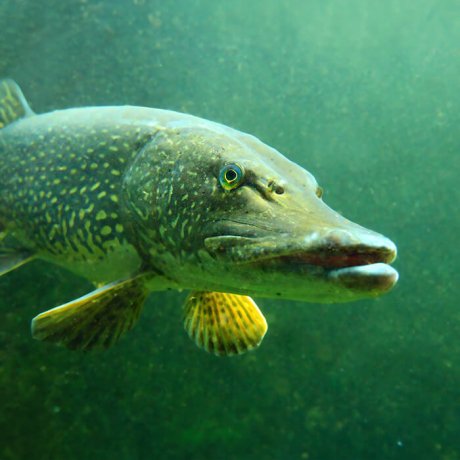
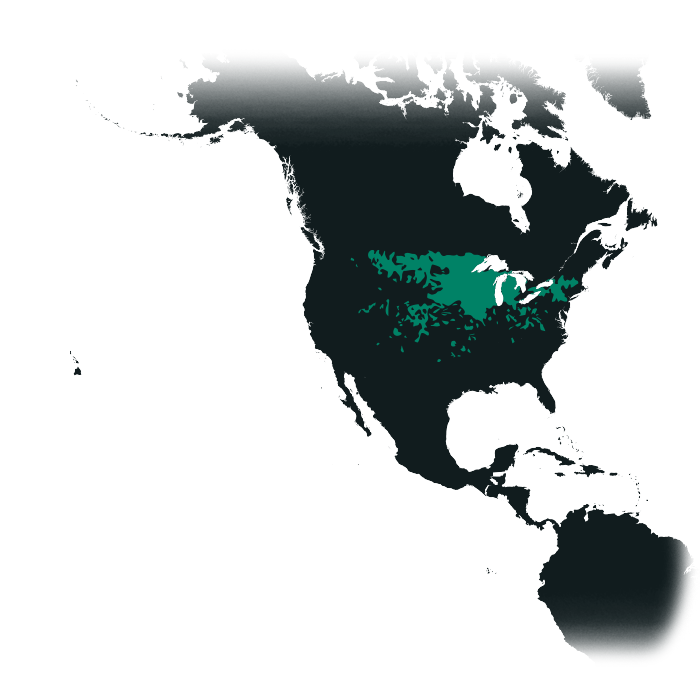

Northern Pike
Esox lucius
Size
Typically 16-22 in. (40-55 cm) in body length, 1-2 lbs (0.4-1 kg).
Habitat
Can be found in shallow, slow-moving weedy water or cold, clear rocky waters, typically in lakes or reservoirs.
Conservation Status
Least concern, relatively common and adaptable. Populations are often augmented by the stocking of hatchery-raised fish.
Diet
Voracious predators who will consume any living thing they can catch. Prey items include invertebrates, any smaller fish (including smaller pike), and any terrestrial vertebrate that enters the water they live in. They have been observed preying upon adult ducks.
Natural History Nuggets
- Record length of 59 inches (150 cm) and weight of 63 lbs (28 kg)!
- Ambush predators who will sit motionless and rely on camouflage to hide from prey, then suddenly strike with a burst of uncontrolled fast swimming.
- Pike are an exotic invasive species in Alaska and threaten salmon populations.
- They are considered a great sport fish and large pike are trophy fish for anglers.
- Care must be taken in handling pike due to their many large, sharp teeth.
- Often hybridize with the similar Muskellunge, creating “Tiger Muskies”, which grow much faster than either parent species but cannot reproduce.
- Preyed upon by otters.
Conservation Concerns, how you can help!
- You can help Northern Pike and all fish by purchasing a fishing license which helps to protect fish habitat and boost populations.
- You can help improve water quality for fish by cleaning up trash around roadways, using less road salt in winter, and planting native plants in wetlands and near streams.
- Never move fish between different waterways.
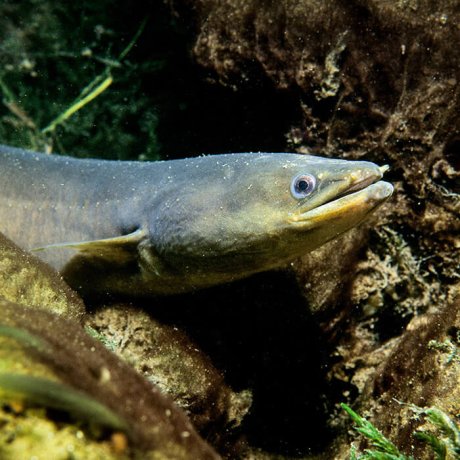
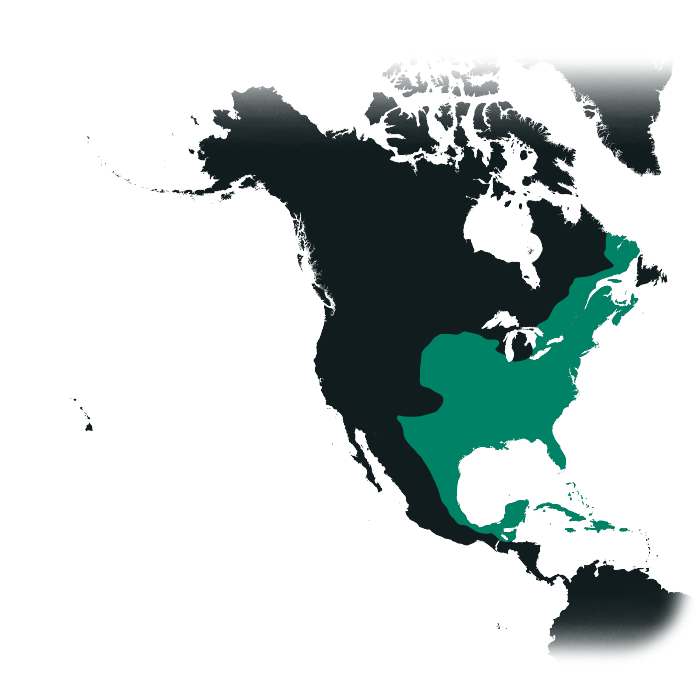

American Eel
Anguilla rostrata
Size
Up to 4 ft (1.2 m) in length and up to 17 lbs (7.5 kg).
Habitat
Bottom-dwellers, living on the floor of a variety of different freshwater and marine habitats.
Conservation Status
Listed as Endangered by IUCN, due to many factors. Has been considered for federal endangered species listing but is not yet listed.
Diet
Carnivorous, feeding on aquatic worms, crustaceans, insects, mollusks, and smaller fish.
Natural History Nuggets
- American Eels are impressive and unique fish who are found in the Lehigh River and its tributaries
- American Eels live most of their lives in inland bodies of freshwater, but migrate far into the Atlantic Ocean to breed.
- Females lay 4 million eggs, then die after egg-laying.
- Eels have several life stages, including transparent “glass eels” that migrate from pelagic waters in which they were hatched towards the coast, often washing up on beaches.
- Older “yellow eels” enter river mouths and move from estuaries to inland fresh water as they gain pigment.
- Adults or “silver eels” live in fresh water bodies for up to 25 years before migrating back to the ocean to end their life cycles.
- Their journey inland can be up to 3,700 mi. (6,000 km) and can take years to complete.
- American Eels are economically important as both fish bait and as a culinary delicacy.
- Preyed upon at younger stages by predatory fish and gulls, and as adults by eagles, ospreys, herons, and otters.
Conservation Concerns, how you can help!
- Their complex lifecycle makes them vulnerable to many threats, and northeastern populations have seen over a 90% decline.
- Dams block migration of eels to their spawning grounds, preventing reproduction.
- Overharvesting of the glass eel and elver stages for food has greatly hurt their populations.
- Eels are sensitive to low oxygen levels found in dammed streams and areas with pollution.
- Eels are outcompeted by several exotic invasive fish species.
- You can help eels by avoiding purchasing unsustainably caught fish, and by not polluting waterways.



